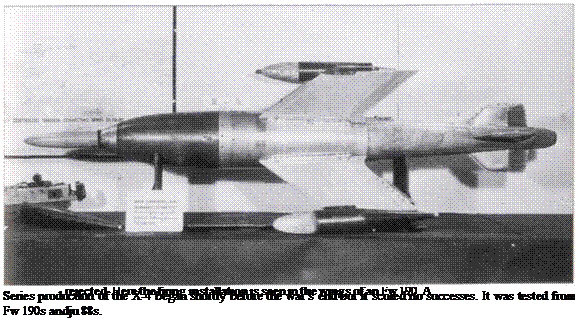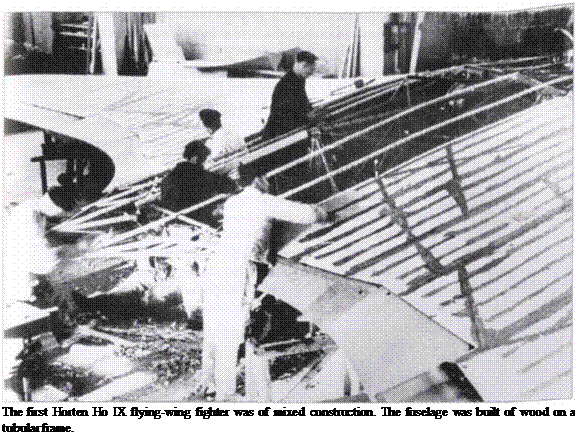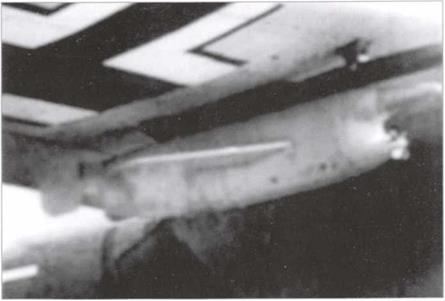RZ65
Besides the R4M, the Me 262 A-la was suitable for carrying the RZ 65 7.3-cm calibre air-to-air Fohn solid-fuel rocket successfully tested aboard the Fw 190 A. The first Me 262 trials with the weapon were held at Tarnewitz in the early spring of 1945 under Flight-Staff Engineer Heinz Pfister. After delays for bad weather, on 25 April he flew an Me 262 from the test centre to JV 44 at Munich- Riem but finding the airfield cratered and two P-5 Is approaching he abandoned the project and headed for Neubiberg. Fohn rockets were now overtaken by events as American troops occupied Munich.
X-4
The wire-guided Ruhrstahl X-4 designed by Dr Max Kramer was a highly valuable weapon scheduled to replace most spin-stabilised rockets at the earliest opportunity. On 30 October 1944 Reich Minister Speer ordered its immediate development. Relatively expensive-looking even from the planning stage, 5,000 Type 8-344 A-l were to be mass-produced monthly at the Ruhrstahl AG works Brackwede near Bielefeld. Fritz Hahn reported that eventually 950 were produced at Bielefeld and the Stargard factory in Pomerania. BMW Berlin – Spandau aimed to turn out 1,500 liquid-propellant motors by April 1945, but few came off the lines complete. On 6 February Kammler ordered X-4 development work concluded as soon as possible to enable the manufacturer to press ahead with the Dogge automatic aiming device. In February 1945 it was still

hoped to arm all operational jet aircraft, including Ar 234 B-2s, C-3s and the Me 262 A-la with the X-4. Numerous tests were made using a converted Ju 88 G. At the beginning of 1945 Messerschmitt works pilot Gerd Lindner made at least one flight aboard an Me 262 A-la (Works No. 111994) carrying
two X-4s below the wings, but they were never fired in combat. The intention for operations was to have two or four X-4s suspended below the wings from an ETC 70/C1. After an air raid destroyed the assembly plant for the BMW 109-548 motor, and the necessary components could not be supplied in the desired quantities, the Riistungsstab accepted that series production in adequate numbers would not be possible. A large number of prototypes survived, and in March 1945 Kammler ordered 300 X-4s. Nothing came of this despite continuing tests at Karlshagen, mainly for the lack of experienced technical staff. Once it was evident that series production was out of the question, the Riistungsstab went for the RM4 instead.
Hs298
The Riistungsstab conference of 5 November 1944 decided that the X-4 should be followed by the air-to-air Hs 298, two or three being carried below the wings of an Me 262 and fired from simple retaining rails. The Hs 298 had been under development at Henschel since 1943. An order was placed for 100 units of the prototype Hs 298 V-l series, to be followed by the V-2 series. The first completely successful launch occurred on 22 December 1944 from a Ju 88 G-l night fighter, and OKL then ordered Henschel to manufacture a pre-series run of 2,000. Although flight and remote-control trials proved promising in early 1945, a disadvantage of the weapons was thought to be its expense. Production
|
The Hs 298 was a technically very complicated heavy rocket whose development was abandoned in 1945. |

of the first 135 continued into the spring of 1945, however. The rocket had some notable innovations in that it was the first to be built in modular form. It was the first guided missile to be fired from a rail, a method only used previously for spin-stabilised rockets. It had no need for batteries, power being supplied by an on-board generator.
The Hs 298 V-2 series had a 45-kg (100-lb) warhead and a range of 5,500 metres (6,000 yd). Speed calculated in 1945 was around 250 m/sec (820 ft/sec). By mid-April 1945 more than 100 of the first 135 prototypes were ready but were destroyed together with the remainder to prevent their capture by Russian forces as the latter neared the Wansdorf factory outside Berlin. Accordingly, with the exception of the R4M, all efforts of the SS to introduce accurate air-to-air rockets over the Reich came to nothing.











